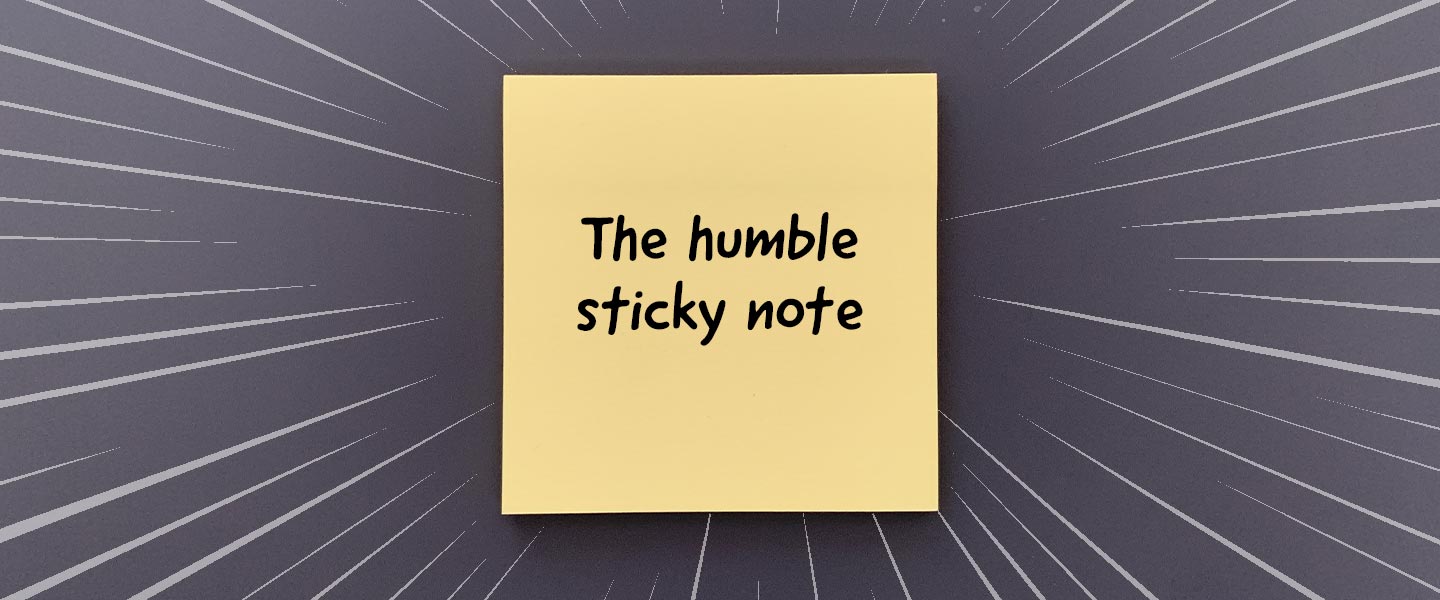The sticky note has been a part of the modern work environment almost as long as personal computers. They line the frame of your monitor. They’re all over your fridge and family calendar. They’re strategically placed around the house, office, and garage to remind you to do stuff. And if you practice human-centered design, then you probably have a reputation for using lots of them. The sticky note (or Post-It® Note, if you want to be brand-specific) isn’t just a cliché background element to office life — it’s an elegant device waiting for you to use it to its fullest potential.
Like a superhero, the sticky note was created in a laboratory… by accident — the story of how a chemical mishap led to a world-changing office product is well-documented. Over the past 40 years or so, sticky notes have gone from being a niche product in Idaho to being more common than No.2 pencils. And while they come in all shapes and sizes, the simple 3×3 inch square note is the star of the show.
It’s easy to think of the sticky note as just an adhesive scrap of paper — but there’s more to it! Here are some key features of the sticky note that you may not have thought about:
- A 3×3 inch pad of sticky notes fits perfectly in the palm of most hands. A new pad is thick enough that you can write on it while standing at a whiteboard or sitting at your desk.
- The back is sticky but not too sticky, which gives you the ability to move it over and over again. This is key in the realm of human-centered design: when you’re trying to make sense of a complex situation through Affinity Clustering or sifting through ideas in a Creative Matrix, the ability to move notes around is essential.
- The 100 notes in the pad are plain, unbound, and present themselves as an approachable tool for everyone. The everyday nature of the sticky note removes all barriers to using it — unlike fancy software or a coding language. If you’re brainstorming at a whiteboard, everyone can share ideas that carry equal weight.
Using sticky notes is fun because they are so versatile. You can use them in so many ways, without needing any instructions. Think about how you use them. Do you cram a 20-point bulleted list on a single note? Do you take a fine tip pen and doodle small circles all over them? Do you fold them in half so they aren’t sticky anymore? You can do that!
When it comes to getting the most out of sticky notes, especially for the practice of design thinking, I’ve got some tips and tricks to consider:
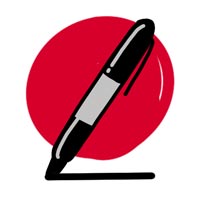
Be bold: Use a thick marker (like a Sharpie® … trust me, we don’t make any commission on recommending office supplies). The thick marker lets you read the sticky note from a distance, which is great for meetings. It also allows your idea to feel big and bold!
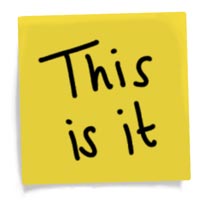
Be concise: Use that thick marker to write just one idea per note. This forces you to keep ideas succinct. There are other tools to use if you want to write long, detailed paragraphs — but a sticky note is really powerful if it’s quick and clear to understand. (Pro tip: the same goes for using “sticky notes” on digital whiteboards like MURAL and Miro.)
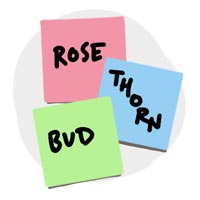
Be colorful: Use different colors for different purposes. If you only have canary yellow, or a pad of sticky notes from your real estate agent, that’s okay! But if you have access to various colors, you can use those notes for organizing information, like with Rose, Thorn, Bud. Color-coded stickies have layers of meaning beyond what’s written on them.
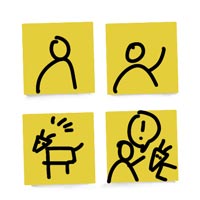
Be creative: Use the shape to your advantage! Need a quick Storyboard? Just throw down six notes in a grid. If you’re trying to organize information in a table, use the sticky notes as cells. If you need to Visualize the Vote, they’re great for that, too.
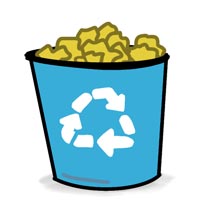
Be productive: Sticky notes are designed to be used quickly and then tossed. Don’t worry about writing perfect prose; just get the idea out of your head! Don’t be afraid to use lots of them; they aren’t precious. I love peeling sticky notes off a wall, crumpling them in my hands, and tossing them in the recycling bin. It’s a great way to visualize progress. There’s a tangible, physical satisfaction that comes with finishing a job. Try it right now… grab a sticky note, crumple it up, and toss it in the bin. It feels great!
With great power comes great responsibility; just having sticky notes, or covering your workspace with them, is not enough. They’re a tool for getting things done. Use them to visualize complex ideas; as quick and easy doodle pads; as concise, color-coded feedback machines. They help us diverge by capturing hundreds of ideas, and then converge by picking the best ones. Their lack of permanence allows us to iterate. Their size means they fit in your pocket. Their ubiquity means they don’t need to be used sparingly. They are more than just tiny squares for your grocery list (although they’re good for that, too).
Make the most of your sticky notes. Write. Crumple. Recycle. Repeat.
PS: If you have a LUMA Workplace® account, I highly recommend this video by Patrick Sharbaugh that includes even more facilitation tips about how to use sticky notes for human-centered design.

